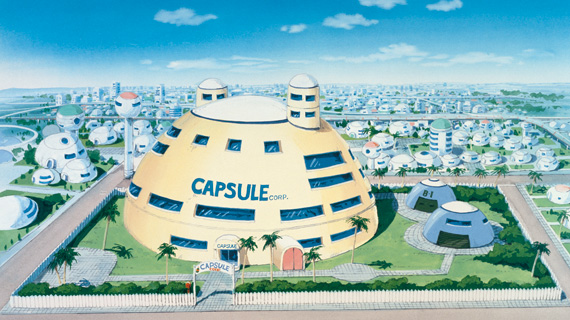Toei Animation’s official English-language website reports that Dragon Ball will be included as an example in a new exhibit on display at London’s Barbican Art Gallery:
Starting from March 23, Dragon Ball will be featured at the prestigious Barbican Art Gallery in London. It is part of The Japanese House Architecture and Life after 1945, an exhibition held until June 25, and co-organized by the Japan Foundation and the Barbican.
An extract of the original 1986 animated series will showcase the inventive world of Dragon Ball and the famous Capsule houses created by Akira Toriyama, and draw parallels with the actual work of visionary Japanese architects from the 1970’s.

The gallery’s official website describes “The Japanese House Architecture and Life after 1945”:
The Japanese House: Architecture and Life after 1945 is the first major UK exhibition to focus on Japanese domestic architecture from the end of the Second World War to now, a field which has consistently produced some of the most influential and extraordinary examples of modern and contemporary design. Featuring over 40 architects, ranging from renowned 20th century masters and internationally celebrated contemporary architects to exciting figures little known outside of Japan, the exhibition celebrates some of the most ground-breaking architectural projects of the last 70 years.
At the heart of the exhibition is an ambitious and unprecedented full-size recreation of the Moriyama House (2005) by Pritzker-prize winning architect Ryue Nishizawa (SANAA). Visitors can weave in and out of the fully furnished units and garden, experiencing the remarkable house of Mr Moriyama in an immediate and physical way. Filling the other half of the Barbican’s lower galleries will be an eccentric and lovingly crafted Japanese tea house, commissioned for the exhibition from acclaimed architect, and highly respected historian of Japanese architecture, Terunobu Fujimori.
Considering developments in residential architecture in the light of important shifts in the Japanese economy, urban landscape, and family structure, the exhibition features over 200 works including rarely seen architectural models and drawings, photography and films, in order to cast a new light on the role of the house in Japanese culture.
At certain times during the exhibition run, tea ceremonies are performed for exhibition ticket holders in the Art Gallery within the garden of the tea house designed by Fujimori. The ceremony is demonstrated by the Urasenke Foundation Tea Ceremony Masters, a 400 year old Japanese Tea Ceremony School.
The Japanese House: Architecture and Life after 1945 is curated by Florence Ostende (Barbican Centre, London), in collaboration with Pippo Ciorra (MAXXI, National Museum of the 21st Century Arts, Rome). The Chief Advisor is Yoshiharu Tsukamoto (Atelier Bow-Wow/Tokyo Institute of Technology). The Academic Advisor is Hiroyasu Fujioka (Professor Emeritus, Tokyo Institute of Technology). The exhibition designer is Lucy Styles. The Fujimori tea-house is designed by Terunobu Fujimori in collaboration with architect Takeshi Hayatsu and built by students from Kingston University.
The exhibition is co-organised by the Japan Foundation and the Barbican Centre and co-produced by the Japan Foundation, the Barbican Centre, MAXXI National Museum of the 21st Century Arts, Rome and the Museum of Modern Art, Tokyo. The project was initially conceived in Tokyo by Kenjiro Hosaka (MOMAT) and Yoshiharu Tsukamoto.
The exhibit is running now and will continue through 25 June 2017. Tickets are available at various prices for certain age groups and membership levels. A 230-page, hardcover catalog complementing the exhibit is available on the gallery’s website for £35.00; international shipping appears to be available for £25.00.
Thanks to Baggie_Saiyan for the heads-up!